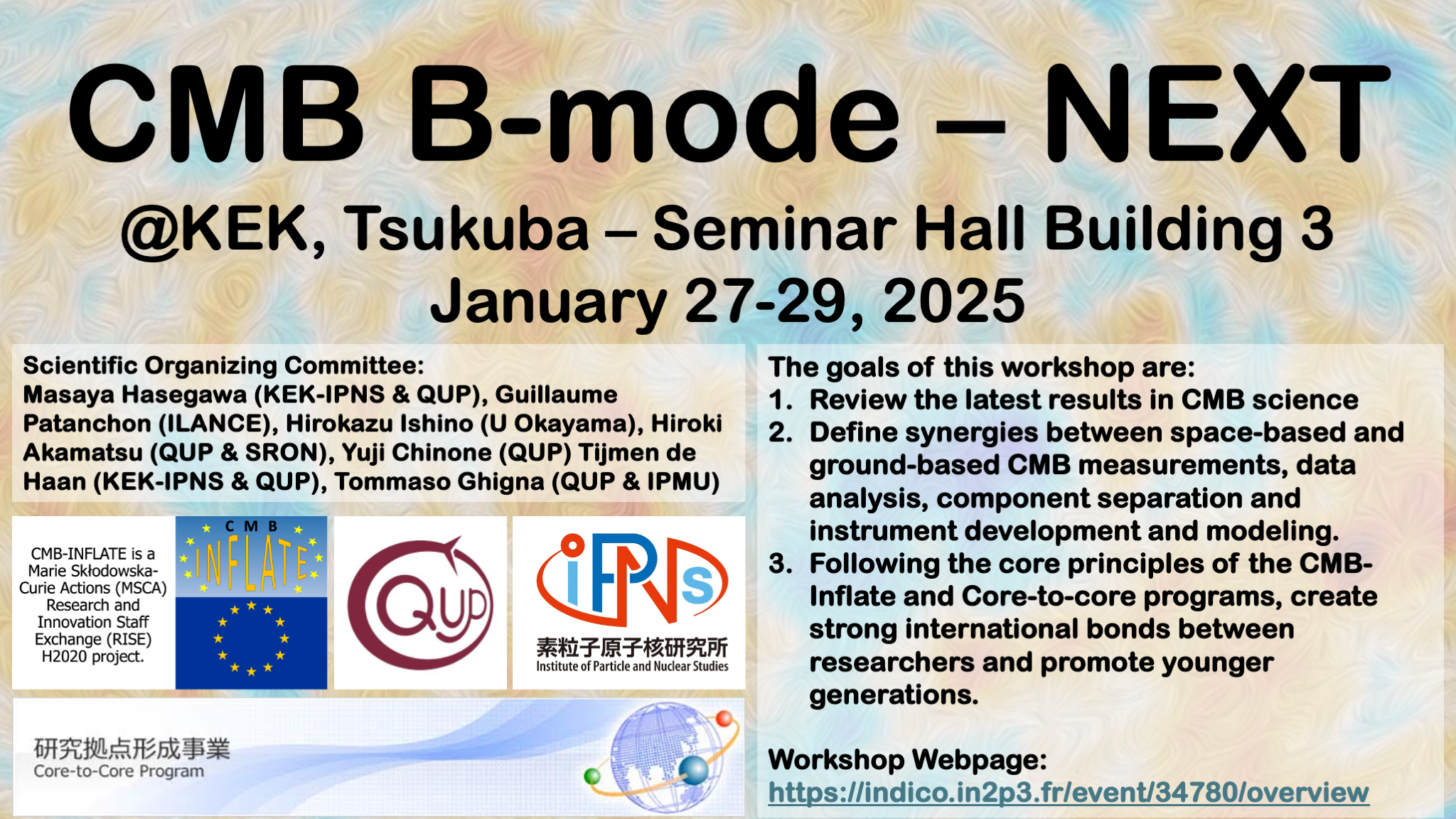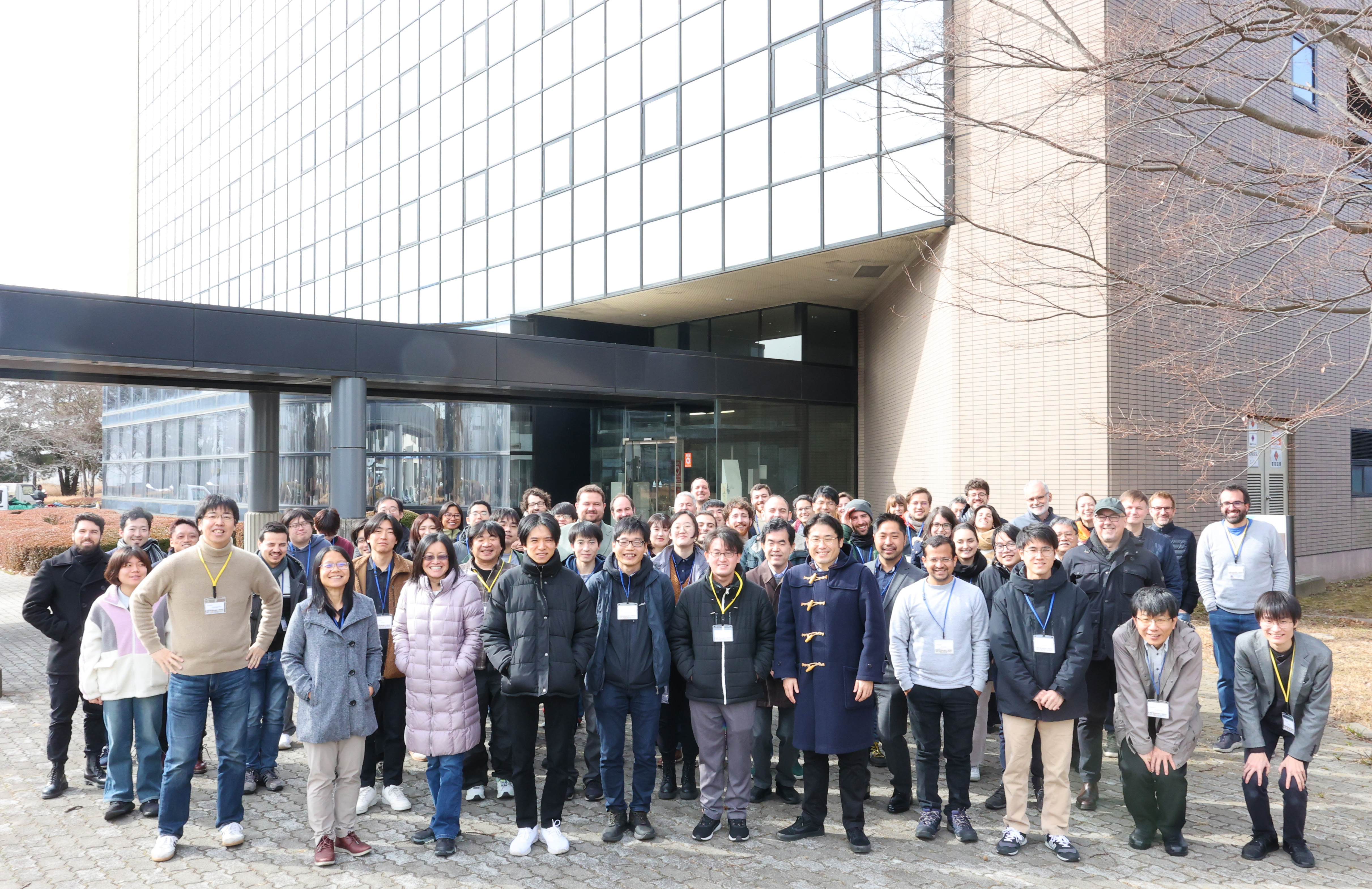CMB B-mode - NEXT
Seminar Hall
KEK, Tsukuba - Building 3
This workshop is organized as a collaboration between:
- CMB-Inflate program - funded by European Union’s Horizon 2020 research and innovation programme under the Marie Skłodowska-Curie grant agreement No 101007633,
- JSPS Core-to-core Program - Exploration of the origin and evolution of matter and space time: a research consortium for cosmic microwave background, PI Akito Kusaka,
- The KEK Institute of Particle and Nuclear Studies KEK-IPNS,
- The International Center for Quantum-field Measurement Systems for Studies of the Universe and Particles WPI-QUP.
The goals of this workshop are:
- Review the latest results in CMB science
- Define synergies between space-based and ground-based CMB measurements, data analysis, component separation and instrument development and modeling.
- Following the core principles of the CMB-Inflate and Core-to-core programs, create strong international bonds between researchers and promote younger generations.
Zoom link for remote attendance:
- https://us02web.zoom.us/j/87235264445?pwd=zr3hL6sKfHAllimokbcu5mJ6bRwOax.1
- Meeting ID: 872 3526 4445
- Passcode: 236700


-
-
09:30
→
09:45
Coffee 15m
- 09:45 → 09:50
-
09:50
→
10:00
Opening Remarks 10mOrateur: Prof. Naohito Saito (KEK-IPNS)
-
10:00
→
10:25
CMB Polarization measurements with BICEP/Keck 25mOrateur: Kimmy Wu (SLAC National Accelerator Laboratory)
- 10:25 → 10:50
-
10:50
→
11:10
Coffee Break 20m
- 11:10 → 11:35
- 11:35 → 12:00
-
12:00
→
13:30
Poster Session
-
13:30
→
14:30
IPNS Seminar: Observing the First Light in the Universe, from the Earth and from the Sky 1h
Since Penzias and Wilson discovered the cosmic microwave background (CMB) in 1964, observation of CMB has been central to the development of modern and precision cosmology. Combined with other probes, it has told us so many things about the Universe - how the Universe began, how the Universe has evolved, what the universe is made of, and still, how many questions are unsolved about the Universe. Throughout its history, the CMB observation has gone through a unique progression - ground-based telescopes, balloon-borne telescopes, and space missions have helped one another and contributed to scientific advancement in their own ways. I am new to the field compared to the history, and I may be out of my depth, but I will make my attempt to review this history and the nature of the CMB observation to realize the synergy between the observations from the ground and the sky. This leads us to the discussion relevant today: how the CMB observations from the ground and the sky may work together now and in the future. I will review the synergies and complementarity between these different approaches, with a focus on CMB polarization measurements, and conclude with a promising outlook for the field.
Orateur: Akito Kusaka (University of Tokyo) - 14:30 → 15:00
-
15:00
→
15:30
CMB detectors & readout and how to model them in data analysis 30mOrateur: Tijmen de Haan (KEK-IPNS & QUP)
-
15:30
→
16:00
Coffee Break 30m
- 16:00 → 16:30
-
16:30
→
17:00
Synergy Between Space and Ground Based Observations: Instruments 30mOrateur: Aritoki Suzuki (LBNL)
-
17:00
→
17:30
Synergy Between Space and Ground Based Observations: Data Analysis 30mOrateur: Luca Pagano (Universita' di Ferrara)
-
09:30
→
09:45
-
-
09:30
→
10:00
Coffee 30m
-
10:00
→
11:00
Basics of TES microcalorimeter/bolometer and non-astronomy applications 1hOrateur: Kazuhisa Mitsuda (QUP)
-
11:00
→
11:20
Coffee Break 20m
-
11:20
→
12:15
Machine Learning and Artificial Intelligence 55m
-
AI for hardware in High Energy Physics 20mOrateur: Louis Vaslin (QUP)
-
A Fast Map-Level Emulator for Extreme Augmentation of Small CMB Systematics Datasets 15mOrateur: Paolo Campeti (INFN Sezione di Ferrara)
-
-
12:15
→
13:30
Lunch 1h 15m
-
13:30
→
15:30
Galactic Foregrounds and Component Separation 2h
-
Foreground modeling for CMB B-modes observations: Synchrotron emission 15mOrateur: Nicoletta Krachmalnicoff (SISSA)
-
Modelling of the polarized thermal dust signal: review and prospects 15mOrateur: Leo Vacher (SISSA)
-
Component separation with no (few) assumptions: ILC methods 15mOrateur: Alessandro Carones (SISSA)
-
Foreground cleaning - Minimally informed component separation 15mOrateur: Clement Leloup (Kavli IPMU)
-
Systematic Effect Mitigation in Parametric Component Separation 15mOrateur: Baptiste Jost (Kavli IPMU)
-
Discussion: Current Priorities on Foreground Cleaning and Modeling 30mOrateur: Carlo Baccigalupi (SISSA)
-
-
15:30
→
16:00
Coffee Break 30m
-
16:00
→
17:45
Instrument Modeling and Systemtic Effects 1h 45m
-
Towards a parametric model to describe HWP non-idealities for primordial B-modes detection 15mOrateur: Ema Tsang King Sang (APC)
-
Impact of HWP non-idealities on the observed CMB polarization 15mOrateur: Marta Monelli (Kavli IPMU)
-
Implementation of HWP Intensity to Polarization Leakage in LiteBIRD simulation framework 15mOrateur: Miguel Gomes
-
Half-Wave Plate Pros & Cons 30mOrateurs: Andrea Occhiuzzi (Universita' di Roma-Sapienza), Fabio Columbro (Universita' di Roma-Sapienza), Satoru Takakura (University of Tokyo)
-
-
09:30
→
10:00
-
-
09:30
→
10:00
Coffee 30m
-
10:00
→
10:30
Neutrino Physics 30mOrateur: Volodymyr Takhistov (QUP)
-
10:30
→
11:00
Instrument Modeling and Systemtic Effects 30m
-
Detector modeling and non-linearity knowledge requirements for LiteBIRD 15mOrateur: Silvia Micheli (Universita' di Roma-Sapienza)
-
HWP and systematics effects with asymmetric beams 15mOrateur: Yuya Nagano (Okayama University)
-
-
11:00
→
11:20
Coffee Break 20m
-
11:20
→
12:20
Instrument Modeling and Systemtic Effects 1h
-
Requirements on gain calibration and beam far sidelobes knowledge for LiteBIRD 15mOrateur: Florie Carralot (SISSA)
-
Study on Feedback-controlled Beam Sidelobe Calibration Measurement for Future CMB Telescopes 15mOrateur: Haruaki Hirose (Yokohama National University)
-
Beam and sidelobe modeling using optical simulations for the LiteBIRD Low-Frequency Telescope 15mOrateur: Fred Matsuda (ISAS-JAXA)
-
Laboratory beam measurements of millimeter-wave telescopes for LiteBIRD 15mOrateur: Hayato Takakura (ISAS-JAXA)
-
-
12:20
→
13:30
Lunch 1h 10m
-
13:30
→
15:30
Data Analysis Techniques and Mitigation of Instrumental Effects 2h
-
Mapmaking & Systematic Effects Mitigation 30mOrateur: Radek Stompor (APC)
-
The Simons Observatory Analysis of Small Aperture Telescopes 15mOrateur: Tomoki Terasaki (University of Tokyo)
-
A measurement of Atmospheric Circular Polarization with POLARBEAR 15mOrateur: Takuro Fujino (Yokohama National University)
-
Requirements on bandpass resolution and measurement precision for LiteBIRD 15mOrateur: Serena Giardiello (Cardiff University)
-
Systematic effects mitigation by spin moment decomposition 15mOrateur: Yusuke Takase (Okayama University)
-
BrahMap: A one-stop shop for CMB map-making 15mOrateur: Avinash Anand (Universita' di Roma Tor Vergata)
-
Discussion 15mOrateur: Radek Stompor (APC)
-
-
15:30
→
15:50
Coffee Break 20m
-
15:50
→
17:20
Likehood and global analysis 1h 30m
-
Common Analysis Methods in Ground & Space CMB Experiments 30mOrateur: Yuji Chinone (QUP)
-
Robust constraints on tensor perturbations from cosmological data: A comparative analysis 30mOrateur: Giacomo Galloni (Universita' di Ferrara)
-
Cosmoglobe: Global analysis of the microwave and infrared sky 30mOrateur: Mathew Galloway (Oslo University)
-
- 17:20 → 17:35
-
09:30
→
10:00
